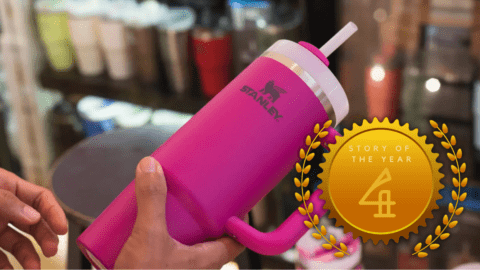AI already has affected shopping habits for large numbers of consumers, and its ability to make hyper-personalized product recommendations — and also to find the best prices and deals — will continue to accelerate the technology’s use. According to Salesforce, during the 2025 holiday season AI will drive $260 billion in global online sales as well as $1.6 trillion in in-store sales.
Salesforce’s Caila Schwartz, Director of Consumer Insights and Strategy, shared other key predictions for the coming holiday season, including:
- Consumers cutting back and seeking value: One in three U.S. shoppers report buying less than usual over the past six months, and 55% are prioritizing essentials, with 70% trading down for lower-priced goods;
- AI has become part of gift-giving processes: 39% of shoppers use AI-powered search at some point in their shopping journey, and 39% of millennials and Gen Z consumers use AI search in-store. Among those using AI in the U.S., more than half (58%) plan to use AI for gift inspiration;
- Resale will benefit from uncertainty over tariffs and international sourcing challenges: In the U.S., 21% of consumers say they’ll seek out secondhand items due to tariff-induced price increases or shortages, and more than twice as many — 47% — say they are likely to gift a resale item this holiday season. Overall, Salesforce forecasts that $64 billion in holiday sales will be resale; and
- Gen Z likes in-person shopping: Three in four Gen Z shoppers plan to shop in-store at some point during the holiday season, with 56% daring to brave the crowds on Black Friday (along with 55% of millennials). For every $1 Gen Z shoppers spend online, Salesforce predicts they will spend $3 more in-store.
Despite Uncertain Economic Conditions, Many Consumers Remain Optimistic
“This year, there’s a tough economic reality for consumers: a high cost of living and high interest rates,” said Schwartz during a conference call discussing the results. “Additionally, supply chain challenges, exacerbated by tariffs, are creating more uncertainty for both retailers and shoppers. Consumers are confused about what it will mean in terms of both pricing and availability: Are shelves going to be stocked with what they want, when they want it?”
While there’s certainly evidence that consumers are tightening their belts, with 55% prioritizing essentials, a surprisingly large number — 41% — of U.S. consumers are optimistic about the current economic climate, compared to 38% in 2024.
“Both U.S. and global consumers say they’re going back to spending, especially for big events like Amazon Prime Day or the holiday season,” said Schwartz. “In 2024, the focus was on savings and paying down credit card debt as people tried to get their financial house in order, but in 2025, they’ll be spending on physical goods — although value will continue to be important.”
AI Shopper Use Cases Continue to Multiply
Salesforce data indicates that 5% of all shoppers now start their product search with AI chat assistants such as ChatGPT, Perplexity and Grok. Among Gen Z consumers, that number is 10%. Perhaps even more important, 44% of U.S. shoppers trust AI recommendations — a remarkably high number for a relatively new set of technologies.
In the U.S., the top reason consumers use AI search is to help them compare prices and find the best deals. The number two reason is that these AI tools give the best personalized product recommendations, and third, consumers appreciate AI’s ability to use photos, videos or audio to search.
“These tools are no longer just helpful add-ons or meme-makers, they’re becoming the bridge between customers and brands, powering a new era of hyper-personalized, real-time shopping experiences,” Schwartz wrote in a recent blog post.
To best position themselves, Schwartz recommended that retailers “evaluate where you’d like your brand to show up when it comes to AI chat assistants. As the chat assistants get more popular, customers will come to expect this kind of personalized one-on-one shopping experience. Drive conversions and loyalty with a guided shopping agent on your own site that guides shoppers through discovery and provides personalized product recommendations.”
Secondhand Becoming Shoppers’ First Choice
It’s not just potentially higher prices for new items that have many consumers turning to secondhand (17% of consumers are shopping resale to combat tariff volatility); it’s also the fear that tariffs and other supply chain challenges will lead to product shortages during the holiday crunch.
For those products that are available, tariffs will eat away at retailers’ margins if they can’t (or won’t) pass along price increases to the consumer. The squeeze on margins also means fewer discounts and promotions during the holiday season: Salesforce predicts that 2% fewer orders this holiday season will transact with a promotional code compared to 2024.
The majority of consumers that buy secondhand are doing so for economic reasons: 68% say gifting resale helps them save money, while 35% say it promotes sustainability and reduces waste.
Gen Z Likes Shopping in Stores — Especially on Black Friday
Gen Z isn’t alone in liking the benefits of in-store shopping: 79% of all holiday shoppers will visit a brick-and-mortar store at some point during the holiday season. “In fact, on the most important shopping days of the year shoppers prefer the store,” Schwartz wrote. “51% of shoppers report that they still prefer to shop in-store on Black Friday, up from 31% in 2024. Gen Z is leading that trend with an incredible 65% reporting their in-store preference for the major deal event.”
Among Gen Z, 72% identified the ability to get products immediately as their top reason for in-store shopping, with 42% expressing their appreciation for being able to touch and feel the merchandise prior to purchase, and 28% reporting that it’s easier for them to browse and discover new products in-store.
This doesn’t mean, of course, that retailers and brands can ignore digital commerce; in fact, quite the opposite. “While the youngest shoppers prefer to shop in-store, they are the most likely to be discovering and researching across many digital channels,” Schwartz wrote, noting that the average shopping journey now has nine touch points prior to a purchase. “Enable your audience to shop your brand, not your channels, by having a robust omnichannel strategy. This is not just an advantage, but a necessity to cultivate loyalty and capture market share.”
















